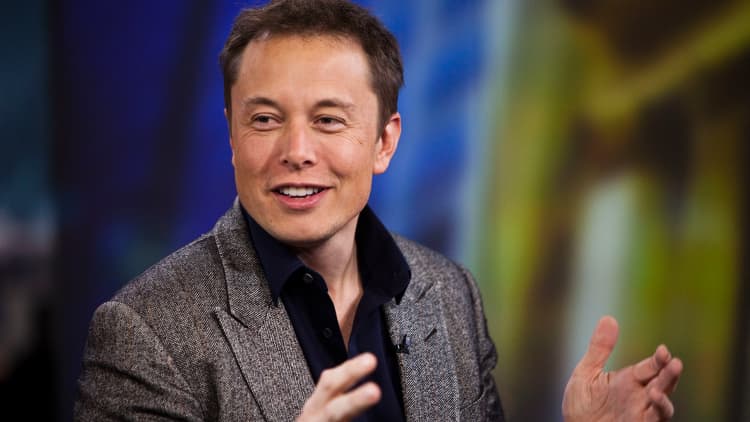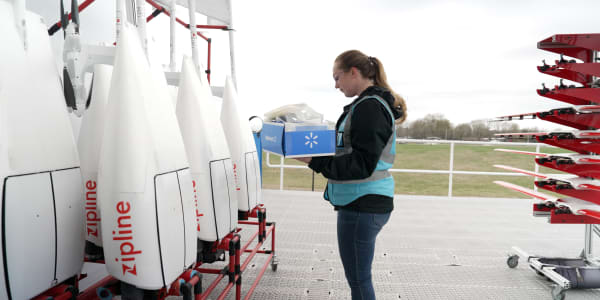
Regardless of any offhand comments President Trump may have made suggesting his administration wants NASA to fast-track a manned mission to Mars — "We want to try and do that during my first term or, at worst, during my second term," he said during a conversation with astronauts last month — technological and fiscal realities suggest that NASA won't be fielding such a mission any time in the foreseeable future.
But if SpaceX CEO Elon Musk has his way, SpaceX could conceivably launch a robotic mission to Mars in 2020 followed by a crewed mission as soon as 2024, before a theoretical second Trump term expires. And that is much sooner than NASA's goal of sending humans to Mars by the 2030s.
While experts agree that such an ambitious mission in such a short timeframe is unlikely, Musk and SpaceX have defied consensus before. Given the somewhat unlikely rapport that's developed between the Tesla and SpaceX founder and President Trump — Musk made two trips to Trump Tower preinauguration, where both Mars and public-private partnerships were reportedly discussed — the idea that SpaceX might be the first to put human footprints on Mars seems less remote than it did a year ago.
So why is Elon Musk so eager to colonize the Red Planet? After all, at 95 percent carbon dioxide, its atmosphere is inhospitable to life, and its harsh climate nearly uninhabitable for humans. Getting there is also a dangerous months-long spaceflight gambit. Nonetheless, Musk has said it's essential to become an interplanetary species lest humans face eventual extinction on Earth, and he believes his company can lead the way off our planet.
Musk's ultimate vision is a Martian city of thousands if not millions of people — one that will require thousands of round-trips and 40 to 100 years to realize. But he's determined to make this vision a reality, first by sending a Dragon 2 capsule to Mars in 2020 — to test out landing procedures, scout locations for future landings and try out technologies needed to land larger, heavier equipment on the Martian surface — and then again every 27 months as SpaceX transports tons of equipment to the Martian surface.
But this vision also presents a unique set of challenges. Before SpaceX can land its first manned mission on the Red Planet, engineers need to develop the company's planned Interplanetary Transport System, a two-part vehicle combining the most powerful rocket ever built, and a massive spacecraft designed to carry at least 100 people to Mars per flight.
After hauling the spaceship into Earth orbit, the ITS rocket will return to Earth, where it or another rocket will then carry a fuel tanker into orbit to rendezvous with and fuel up the orbiting spaceship (which will initially launch with very little fuel on board so it can carry more people and cargo).
Once fueled, the spaceship will light its own thrusters — nine of the Raptor engines SpaceX successfully test-fired for the first time in September — and blast off toward Mars. Musk expects the ITS spaceship to make the trip in just 80 days, far shy of the six to nine months it currently takes spacecraft to travel to Mars.
After making a retro-rocket-assisted soft landing on the Martian surface, this crew would begin constructing habitats and a propellant plant that would allow for the refueling of spacecraft to launch back to Earth, closing the transportation loop and allowing for regular transit to and from the Martian surface aboard the reusable spacecraft.
That's the larger idea, anyhow — one that will require SpaceX to make huge strides in propulsion, life support, rocket design, retro-propulsion (for landing) and other technologies. Regardless of those myriad challenges, Musk continues to talk of sending at least a first, exploratory crewed mission to Mars within the next decade.
"People can smirk," says Marco Caceres, senior analyst and director of space studies at aerospace consultancy Teal Group. "But it's hard to argue with one success after another."
Funding a Mars mission
All this will take money, and that's where SpaceX's commercial space business comes in. The company's mission backlog contains roughly 70 missions that have yet to launch worth some $10 billion. Though SpaceX's finances aren't publicly available, a handful of internal documents obtained by the Wall Street Journal earlier this year showed that the company, though profitable, has been operating with razor-thin margins in an effort to keep costs down.
But that backlog and revenue potential could soon change as the company settles into a faster launch tempo, breaks into new markets, and expands its revenue streams. For instance, starting next year, SpaceX plans to begin deploying a constellation of nearly 4,500 satellites that will blanket the world in Internet connectivity, a business the company reportedly believes will bring in $30 billion in revenue by 2025.
Meantime, given its ability to consistently undercut its launch industry rivals on price (the current list price for a SpaceX Falcon 9 rocket is $62 million, roughly half what the competition often charges), SpaceX's dominant position within the commercial—and now military—launch markets is relatively secure for the time being.
SpaceX's string of recent successes hasn't come without adversity, however. In September of last year, one of its Falcon 9 rockets exploded on the launchpad during pre-flight fueling, incinerating a costly satellite payload along with the launch vehicle. The accident grounded SpaceX's fleet for several months while engineers sought to isolate the cause, marking the second time the company has had to suspend launches after an accident.
Despite that setback, SpaceX has managed to thrive over the past 12 months. It has launched six successful missions since returning to flight in January. With a seventh launch slated for June 1, the company is on pace to launch more than a dozen missions this year—potentially quite a few more than the one-per-month it was averaging in 2016.
It has also brought more than 10 of its first stage boosters safely back to Earth after launch, normalizing a feat that seemed insurmountably difficult just a few years ago. It has successfully refurbished and reused one of those boosters on a second mission, a development that could drastically impact the economics of space launch going forward. And it has successfully broken into the lucrative military launch market, sending its first classified payload for the U.S. Air Force skyward earlier this month.
Key breakthroughs
The latter two developments are particularly relevant to SpaceX's future ambitions for one simple reason: spaceflight is expensive. By breaking into the military satellite space—the one segment of the satellite launch market SpaceX had yet to disrupt—the company has a new $1.9 billion market from which it can draw revenue.
Reusability on the other hand could drastically reduce the costs associated with each launch, allowing SpaceX to improve its margins while cutting its prices further. "The degree to which they have visibly demonstrated return and reuse, that's quite significant," Carissa Christensen, CEO of aerospace consultancy Bryce Space and Technology, says. "That's been a long-targeted industry objective, and SpaceX is the first to do it commercially."
The second payload to ride atop a recovered and refurbished rocket booster will launch next month, and the company could begin seeing significant cost reductions as a result of its reusable rocket technology within two or three years.
I think SpaceX arguably is positioning itself to be the partner of choice for any federally funded or internationally-backed Mars mission.Carissa ChristensenCEO of Bryce Space and Technology
"If you can recover those engines and they're fine, you can save an awful lot of money," Caceres says. "By the time you get to maybe 10 of these kinds of missions, it becomes routine. You start to realize some cost savings, which allows you to start noticeably dropping the price of your missions. And if you can get the price down to 30 or 35 million [dollars] per mission, nobody else can come close to that."
A trillion-dollar budget
What does all this have to do with sending astronauts to Mars? For one, such an interplanetary mission will be extremely expensive, likely measured in trillions rather than hundreds of billions of dollars, Caceres says. One way to enable such a mission is to reduce the cost of space access, spurring economic activity in orbit and beyond which in turn will help create economies of scale that drive costs down further, a point to which Musk has spoken at length.
SpaceX has already succeeded in this regard, cutting the average cost of launch in half with its $62 million Falcon 9 rocket and forcing others in the industry like United Launch Alliance to slash their own prices while also investing in newer, less-expensive launch technologies. If savings from its reusable rocket technology begin to manifest themselves as expected, Caceres says, "theoretically SpaceX could be launching dozens of times per year and at prices maybe one-fourth their competitors'."
More from CNBC Disruptor 50:
Uber vs. Lyft: A race that isn't anywhere near over
Why Warren Buffett is betting on this software start-up
Forget Silicon Valley, this is the red-hot market US start-ups are flocking to
While continuing to drive down cost, SpaceX can also work toward its Mars ambitions by honing technologies and capabilities that position the company to assume a larger workload with its partners in government. In the near-term, two such technologies/capabilities to watch are the company's test of its far more powerful Falcon Heavy rocket later this year and its first crewed missions to the International Space Station aboard its Dragon crew capsule, likely beginning in 2018.
If SpaceX can successfully demonstrate both of those capabilities, Caceres predicts that NASA will come under Congressional pressure to explain why it needs to continue pouring money into the $18 billion Space Launch System, NASA's own super heavy-lift rocket and space capsule. If Congress decides NASA doesn't need to keep funding the Space Launch System, SpaceX would arguably be the best-positioned commercial company to step into its place, making it the de facto launch partner for any federally-funded future Mars mission.
"The name of the game these days is public-private partnerships, because it's clear now that unless Congress dramatically increases NASA's annual budget of just under $19 billion a year, NASA cannot come close to doing the things that it would like to do or that Congress would like it to do," Caceres says. "So you need to find a way to partner with companies that have the technology, the ambition, and the vision, and the only company like that out there frankly is SpaceX."
"I think SpaceX arguably is positioning itself to be the partner of choice for any federally funded or internationally-backed Mars mission," Bryce Space and Technology's Christensen says.
That could change as competitors like United Launch Alliance and Jeff Bezos' Blue Origin bring new rockets and new competition into the commercial launch market at the end of the decade. But with an enviable head start, rapidly growing market share, and an increasingly lucrative launch services business bankrolling SpaceX's ambitions—not to mention a President with a penchant for the grandiose in the White House—Musk's optimism surrounding a future manned Mars mission seems less extreme than it did last year.
While it may happen during Trump's presidency, there's no indication that Musk and company will stop pushing for it—potentially dragging NASA and the U.S. government along with them if necessary, Caceres says.
"There doesn't seem to be anything they're not willing to tackle when it comes to space," he says. "They're not just going to sit back and get a bunch of contracts. That's too boring for Elon Musk."
—By Clay Dillow, special to CNBC.com







